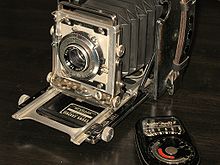Press camera
A press camera is generally understood to be a roll film format camera for use by press staff such as magazine reporters or court reporters. Such cameras were developed from the beginning of the 20th century and used until the 1980s. From then on they were replaced by more manageable 35mm cameras and, at the end of the 20th century, these in turn by DSLRs . Existing cameras of the last series are still popular today due to the image quality for stationary motifs, older ones are more likely to be collector's items.
Historical background
With the increasing spread of photography in the 20th century, the need for photos for magazines and daily newspapers also increased. The film emulsions, which were still comparatively poor at the time, actually required cameras in larger negative formats, such as large format cameras , if you wanted to achieve good image quality. Despite the increasing spread of 35mm photography, there was still a need for photos in larger formats.
Usual large format cameras with two standards mounted on a base in the form of an optical bench were only suitable for mobile use for reports to a very limited extent due to their bulkiness and weight.
For this reason, press cameras were developed that were significantly more compact, robust and lighter than large format cameras for large film formats (usually roll film with 6 × 7 to 6 × 9 cm).
technical structure
This reduction in size was achieved through various measures, not all of which could be found on every press camera:
- More like a box than an optical bench , the lens often retractable
- Closer distance between film and lens due to different lens calculation
- A front standard was dispensed with, or a housing cover was used in front of the lens, which was folded down and had a rail on the inside on which the lens standard could then be moved (the so-called running floor , see large format camera ).
- robust frame that also protects the lens
- Focusing not on a screen on the rear standard, but by means of an optical viewfinder (or even just by estimation)
- Dispensing with adjustment options such as tilting and shifting the standard
- Handgrips or the like to make the camera manageable without a tripod
However, the press cameras remained sophisticated devices with extensive possibilities. Often it was also possible to focus using a focusing screen, there was flexibility in terms of the films used (thanks to interchangeable magazines) and the lenses were mostly interchangeable.
Despite these limitations, press cameras were still large compared to 35mm or medium format cameras, which is why they have increasingly been supplanted by them. More or less the last survivor is the Linhof Technika.
Some representatives:
- Mamiya Universal and Mamiya Press
- Plaubel Makina
- Graflex Speed Graphic
- Graflex XL
- Rapid Omega
- Zeiss Ikon Ideal 225
literature
- Reg Holloway: The Evolution and Demise of the Larger Format Press Camera , Epic Press, ISBN 1-55452-294-3
- Ansel Adams: The camera with Robert Baker (illustrations), Christian Verlag, Munich 1982, ISBN 3-88472-070-8
